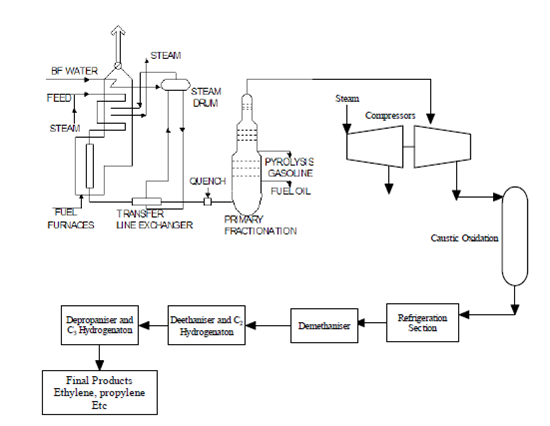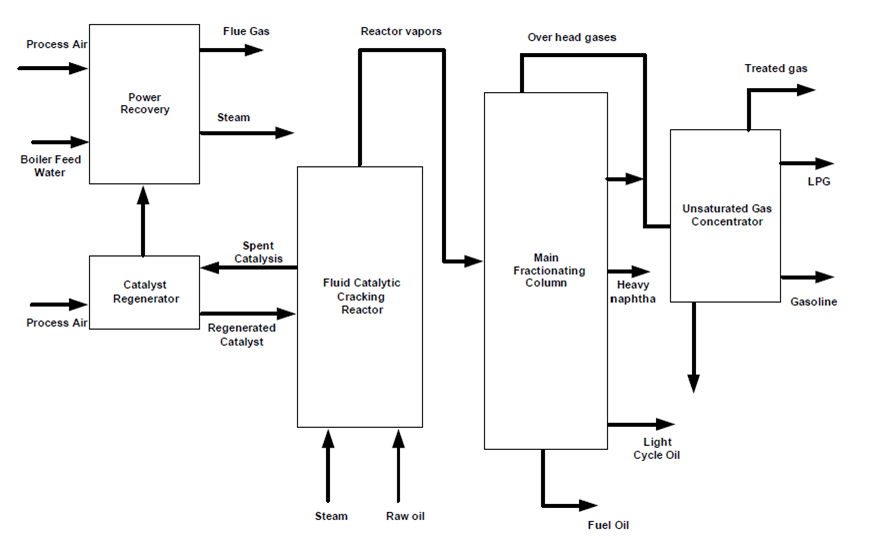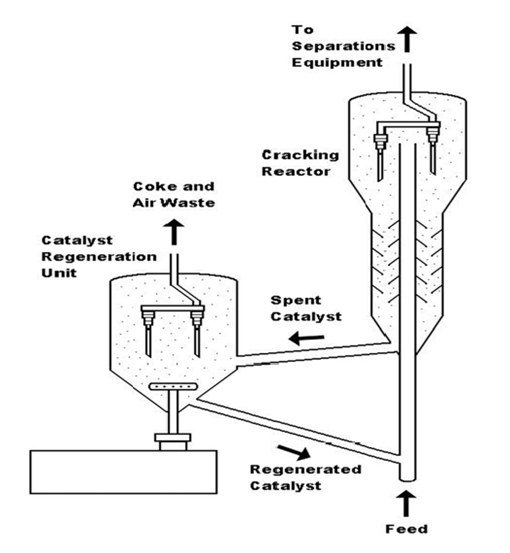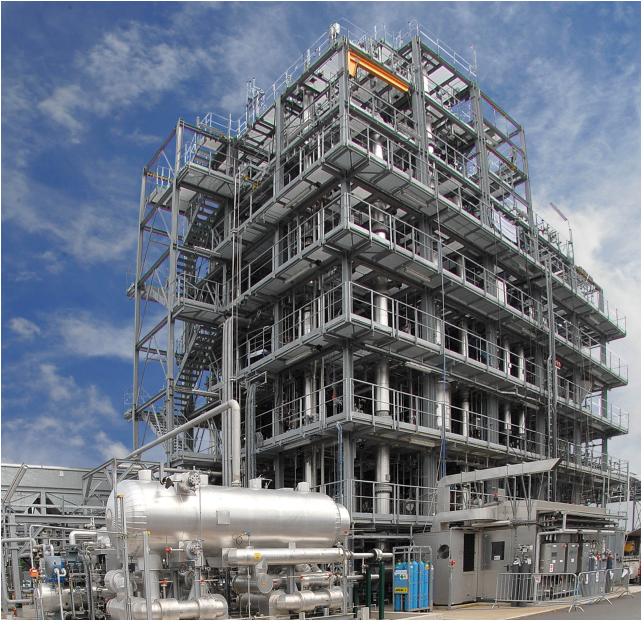Author: Marcello De Falco, Associate Professor, University UCBM – Rome (Italy)
1. Theme description
Olefins, mainly ethylene (C2H4) and propylene (C3H6), are key intermediate and feedstock for the production of a wide number of chemical products, as the polyolefins (polyethylene – PE, polypropylene – PP), Mono-ethylene glycol (MEG), Ethylene Oxide (EO) and derivatives, Propylene Oxide (PO) and derivatives, Polyvinyl chloride (PVC), ethylene dichloride (EDC), Styrene, Acrylonitrile, Cumene, Acetic Acid, etc.
At the present, the worldwide demand of ethylene/propylene is more than 200 million tons per year but the conventional processes suffer for a series of problems as the high cost and low conversion efficiency.
In the following, the traditional technologies, i.e. the Thermal Steam Cracking and the Fluid Catalytic Cracking, are firstly presented. Then the innovation in the olefins production are described and assessed.
2. Olefins production conventional processes
The most used olefins industrial production processes are:
- Thermal Steam Cracking (TSC);
- Fluid Catalytic Cracking (FCC).
TSC is a thermal process by which a feedstock, typically composed by naphtha, ethane or propane, is heated up in a furnace composed by both a convection and radiant section, and mixed with steam to reduce the coke formation. The steam addition depends on the TSC feedstock (from 0.2 kg steam to kg of hydrocarbon for ethane to 0.8 kg steam to kg of hydrocarbon for naphtha).
Then the products (ethylene, propylene, butadiene, hydrogen) are quickly cooled down to avoid subsequent reactions (quenching) and then are separated by means of a series of operations (refer to Figure 1).
The reactions structure involved in thermal cracking is complex and, generally, is based on a free radical mechanism. Basically, two types of reactions are supported in a thermal cracking process:
- primary cracking, with the initial formation of paraffin and olefins;
- secondary cracking, with the formation of light products rich in olefins are formed.
TSC is an energy intensive process: the specific energy consumption per kg of produced olefin is 3.050 kcal/kg.
FCC is a multi-component catalytic system, where the catalyst pellets are “fluidized” thanks to the inlet steam flow-rate and the cracking process is supported at lower temperature than TSC. A typical block diagram is shown in Figure 2, while a FCC reactor drawing is reported in Figure 3.
Olefins production traditional technologies suffer from inefficiency due to high temperature/high energy costs, complex and expensive separation units and significant CO2 emissions.
As a consequence, a strong interest towards the development of more flexible, more efficient with a lower environmental impact and less expensive catalytic olefin production technologies is growing.
In the following, some of the most interesting technologies developed during the last years are presented and described.
Fig. 1 – Thermal Steam Cracking plant layout [1]
Fig. 2 – Fluid Catalytic Cracking block diagram [2]
Fig. 3 – FCC reactor drawing [2]
3. Innovative Technologies
Advanced Catalytic Olefins (ACO)
The Advanced Catalytic Olefins (ACOTM) technology has been developed by Kellogg Brown & Root LLC (KBR) and SK Innovation Global Technology. The process is an FCC-type with an improved catalyst able to convert the feedstock in larger quantities of ethylene and propylene, with a higher share of propylene than conventional processes (the ratio of produced propylene to produced ethylene is 1 versus 0.7 of the commercial processes). The ACO process produces 10-25% more olefins than the traditional FCC processes, with a reduction of consumed energy per unit of olefins by 7-10% [3].
The plant configuration is composed of 4 sections: riser/reactor, disengager, stripper and regenerator. Figure 4 shows a simplified process scheme, while Figure 5 illustrates a picture of the first ACO commercial demonstration unit, installed in South Korea and with a production capacity of 40 kta of olefins.
Fig. 4 – ACO plant process scheme [3]
Fig. 5 – ACO Commercial Demonstration unit installed in Ulsan (South Korea)
PCC Process
The Propylene Catalytic Cracking is a fluid solids naphtha cracking process patented by Exxon Mobil and based on an optimization of catalyst, reactor design and operating conditions set able to modulate the reactions selectivity, leading to crucial economic benefits in comparison with the conventional processes.
The PCC process is able to produce directly the propylene at the chemical grade concentrations, thus avoiding the expensive fractionation units. Moreover, the specific operating conditions allows the minimization of aromatics production [4].
Exxon is testing the innovative solutions on tailored pilot facilities.
Indmax FCC Process
The Indmax process, developed by the Indian Oil Corporation, is able to convert heavy feedstock to light olefins. It is a FCC-type process where the reactions are supported by a patented catalyst, able to reduce the contact time and thus leading to higher selectivity to light olefins (ethylene and propylene).
Another crucial characteristic of I-FCC process is the high production flexibility: the process can be easily adjusted to modulate the output, maximizing propylene, gasoline or producing combinations (propylene and ethylene or propylene and gasoline) [5].
Aither Chemicals’ catalytic process
Aither Chemicals, a company located in the U.S., developed an innovative catalytic cracking process for the production of ethylene, acetic acid, ethylene derivatives as ethylene oxide (EO) and ethylene glycol (EG), polyethylene (PE, LLDPE, HDPE), acetic acid derivatives as acetic anhydride, ethylene-acetic-acid derivatives such as vinyl acetate monomer (VAM), ethyl vinyl acetate (EVA) and other chemicals and plastics [6]. The process uses oxygen instead of water steam and, globally, needs much lower energy (-80%) and produces 90% less carbon dioxide, being more environmentally sustainable.
Moreover, the CO2 and CO streams are captured at the outlet of the catalytic process and utilized for producing chemicals and polymer, thus nullifying the GreenHouse Gases emissions.
The production volumes foreseen for the innovative process are 224 ktons of ethylene, 112 ktons of acetic acid, 30 ktons of CO2 and 15 ktons of CO.
Methane-to-olefins processes
Many research efforts are devoted to find new routes and process configurations to convert directly natural gas to olefins by low temperature reactors.
There are two possible methane-to-olefins (MTO) processes:
- Indirect process, by which methane is converted into syngas, methanol or ethane and then olefins are produced;
- Direct process, by which olefins are directly produced from the methane in a single conversion step composed by modified Fischer-Tropsch reaction.
Even if the direct route seems to be more interesting, at the present not a good light olefins selectivity has been obtained [7] and the MTO processes are more energy intensive than the conventional cracking technologies. The only pre-commercial scale application has been developed by UOP and Total Petrochemicals in Feluy (Belgium): the plan is an indirect process able to produce ethylene and propylene through methanol and syngas.
Fig. 6 – MTO plant in Feluy, Belgium [8]
Some interesting patents have been produced on the MTO topic [9], [10], [11], as well some accurate scientific publications on important international journals [12], [13], [14].
Propane Dehydrogenation
The company UOP developed an innovative Propane Dehydrogenation (PDH) process able to produce ethylene and propylene at lower cost thanks to a lower energy usage and a more stable platinum-based catalyst [15]. The process, called Oleflex, is divided in three sections: the reaction, consisting of four radial-flow reactors, the product purification and the catalyst regeneration. Fig. 7 shows a process layout. Currently, 6 Oleflex units are installed and produce more than 1.250.000 MTA of propylene worldwide.
Fig. 7 – UOP’s Oleflex process layout [8]
Shell Higher Olefins Process
The Shell Higher Olefins Process (SHOP) is an innovative olefins production technology, developed by Royal Dutch Shell, based on a homogeneous catalyst and used for production of linear α – olefins (from C4 to C40) and internal olefins from ethene.
The process architecture consists of three steps:
- Oligomerization (conversion of a monomer or a mixture of monomers into an oligomer, temperature = 90–100°C, pressure = 100–110 bar, polar solvent);
- Isomerization (molecules rearrangement reaction by a metal catalyst, 100–125° C and 10 bar);
- Methathesis (alkenes are converted into new products by breaking – up and reformation of C-C double bonds by an alumina-based catalyst, 100–125° C and 10 bar) [17].
At the present, SHOP is widely applied and the worldwide production capacity is 1.190.000 t of linear alpha and internal olefins per year.
Catalytic Partial Oxidation of ethane
ENI and the Italian research centre CNR developed an ethylene production process through Short Contact Time – Catalytic Partial Oxidation (CPO) of ethane.
The process is supported by a patented monolithic catalyst able to improve the ethylene yield up to 55 wt.% [18].
At the present, the technology has been validated trough a bench-scale unit, by which the optimal operating conditions have been identified. However, the industrial scale application is not ready yet, since an optimization of the CPO reactor design and the improvement of the catalyst reliability are needed.
_______________









